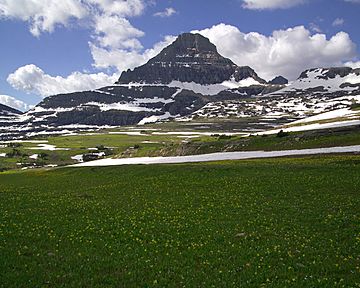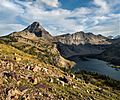Reynolds Mountain facts for kids
Quick facts for kids Reynolds Mountain |
|
|---|---|

Reynolds Mountain as seen from Logan Pass
|
|
| Highest point | |
| Elevation | 9,130 ft (2,780 m) |
| Prominence | 1,285 ft (392 m) |
| Geography | |
| Location | Flathead County, Montana, Glacier County, Montana, U.S. |
| Parent range | Lewis Range |
| Topo map | USGS Logan Pass, MT |
Reynolds Mountain is a cool mountain in Glacier National Park, Montana. It stands tall at about 9,125 feet (2,781 meters) high. This mountain is part of the Lewis Range and is a famous spot in the park.
You can easily see Reynolds Mountain from Logan Pass. Just look south from the pass, and there it is! Below the mountain, to its west, is a beautiful place called Hidden Lake.
Many people enjoy climbing Reynolds Mountain. It's known as a Class 2 or 3 climb, which means it's not too hard for experienced hikers. The easiest way up is usually by following the southwestern slope.
The mountain got its name from Charles E. Reynolds. He was a writer for a magazine called Forest and Stream. He also helped George Bird Grinnell, who was the editor of the magazine. Grinnell named many places in Glacier National Park. The official name for Reynolds Mountain was chosen in 1910 by the U.S. Board on Geographic Names.
Contents
How Reynolds Mountain Was Formed
Rocks and Ancient Seas
Like other mountains in Glacier National Park, Reynolds Mountain is made of sedimentary rock. This type of rock forms from layers of sand, mud, and tiny bits of plants and animals that settle at the bottom of ancient seas. Over millions of years, these layers get pressed together and turn into rock.
The rocks in Reynolds Mountain were formed a very long time ago. This was during periods called the Precambrian to Jurassic periods. Imagine shallow seas covering this area, where these rock layers slowly built up.
The Lewis Overthrust
About 170 million years ago, something amazing happened. A huge geological event called the Lewis Overthrust began. This is when a massive slab of old rock, about 3 miles (4.8 km) thick, 50 miles (80 km) wide, and 160 miles (257 km) long, slowly moved.
This enormous rock slab slid over much younger rock layers. It was like a giant push that lifted the mountains we see today. This process created the stunning peaks and valleys in Glacier National Park, including Reynolds Mountain.
Images for kids
-
Reynolds Mountain by Ansel Adams in 1942








